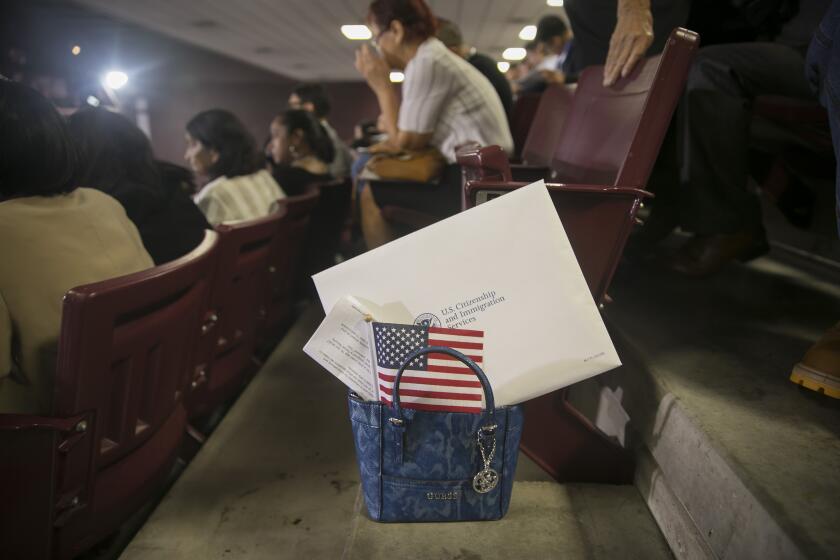Inde-fence-ible?
WHILE President Bush was in Latin America earlier this month, cajoling governments to support a free-trade zone, some members of his party back home were pushing for a fence from the Pacific Ocean to the Gulf of Mexico to keep Latin Americans out of the United States.
Colorado Gov. Bill Owens, Rep. Duncan Hunter of El Cajon and other Republicans have proposed building such a barrier. Hunter’s version, centerpiece of the TRUE Enforcement and Border Security Act that he introduced last week, would include two layers of reinforced fencing, stadium-type lighting, access roads, video surveillance systems and in-ground sensors. To monitor and maintain these new fortifications, Hunter would double the size of the Border Patrol.
Sealing the border is technologically feasible -- that has never been the issue. The real question is whether the United States is willing to pay the high costs of doing so, in terms of scarce revenue and widespread disruptions to our economy and society. The cost of erecting nearly 2,000 miles of border fortifications and permanently deploying the staff to monitor and maintain the fence would run into many billions of dollars.
At least 400 to 500 migrants die each year of dehydration, drowning and other causes related to illegal entry. But that is only a tiny fraction of those who try to cross, so the odds of arriving safely in the U.S. are still quite good. To create a truly effective deterrent, the U.S. would have to make illegal entry life-threatening by authorizing the use of lethal force. A Berlin Wall without border guards with orders to shoot to kill would not have stopped East Germans. Neither would a high-tech fence along the U.S.-Mexico border.
A barrier, however sturdy, also could be tunneled under. Dozens of such tunnels have been detected in recent years along segments of the border that are already fortified.
And like France’s Maginot Line in 1940, a sea-to-sea fence could be outflanked. Even if successful in halting illegal entries along the land border, the fence would promote a brisk new trade by people smugglers, running migrants in boats to the U.S. Pacific and Gulf coasts and transporting them by plane to Canada, with its 4,100-mile, largely open border.
Anyone who considers this scenario farfetched should consider what happened in southern Europe over the last four years. A crackdown by Spain on illegal migrants crossing the Strait of Gibraltar from Morocco immediately shifted the traffic to Spain’s Canary Islands in the Atlantic Ocean. When Spain extended its maritime crackdown to the Canaries, migrants began pouring over border fences in Spain’s enclaves on the North African coast.
Fixed fortifications don’t stop highly motivated economic migrants any more than they stopped Hitler’s mechanized armies in 1940. The track record of the four “concentrated border enforcement operations” in California, Arizona and Texas since 1993 shows that tougher border controls only enrich people smugglers, provoke violence between the smugglers and Border Patrol agents, endanger the lives of migrants and encourage those who overcome the obstacles to settle permanently in the U.S.
Proponents of sea-to-sea fencing insist that a show of force on the border would send a message that the U.S. is serious about immigration control. But my interviews with hundreds of recently returned migrants show that the vast majority already knew about the difficulty and dangers of entering the U.S. clandestinely. This knowledge didn’t discourage them from trying. Central American migrants, who have run a gantlet of bandits and corrupt police just to get to the U.S. border, are even less likely to be deterred by a new fence.
For Latin Americans, sealing the border would be a huge symbolic affront. What democratically elected government in the region could afford to embrace Washington’s policy agenda on trade, security or other issues while the U.S. was literally walling itself off from its Latin American neighbors?
In Mexico, fencing the border would create a political firestorm. Mexican President Vicente Fox is Bush’s strongest ally in the free-trade wars, but if the border fence were built, he would have no choice but to distance himself from U.S. policies. And for the three men competing for Mexico’s presidency in 2006, acquiescing to the fortified border would be political suicide.
Immigration restriction groups and their GOP allies in Congress have largely manufactured the wave of anti-immigration hysteria and cynically tout border sealing as an idea whose time has come. A politically weakened Bush, eager to change the subject from indictments and management failures, apparently sees immigration reform as an area where he might score a quick accomplishment. Since January 2004, the president has promoted his concept of a guest worker program. To get Republicans in Congress to vote for it, he may be tempted to endorse a border-sealing quid pro quo.
It’s time for the Bush administration to pound the stake into this wrongheaded scheme before it does lasting damage to U.S.-Latin American relations and further distracts attention from the issue that should be at the center of our debate over immigration reform: how to create more legal-entry opportunities for immigrants.
More to Read
Start your day right
Sign up for Essential California for news, features and recommendations from the L.A. Times and beyond in your inbox six days a week.
You may occasionally receive promotional content from the Los Angeles Times.






